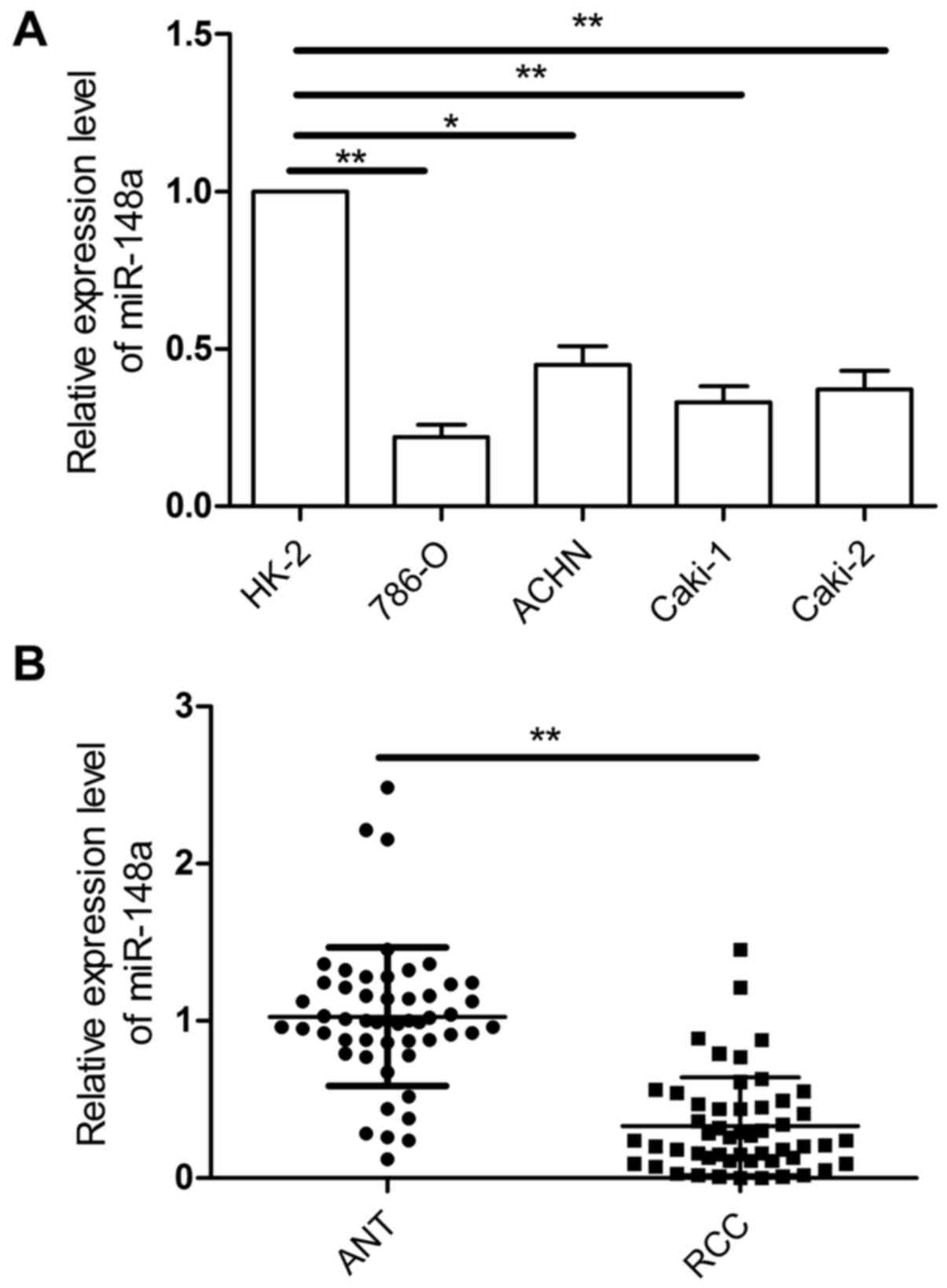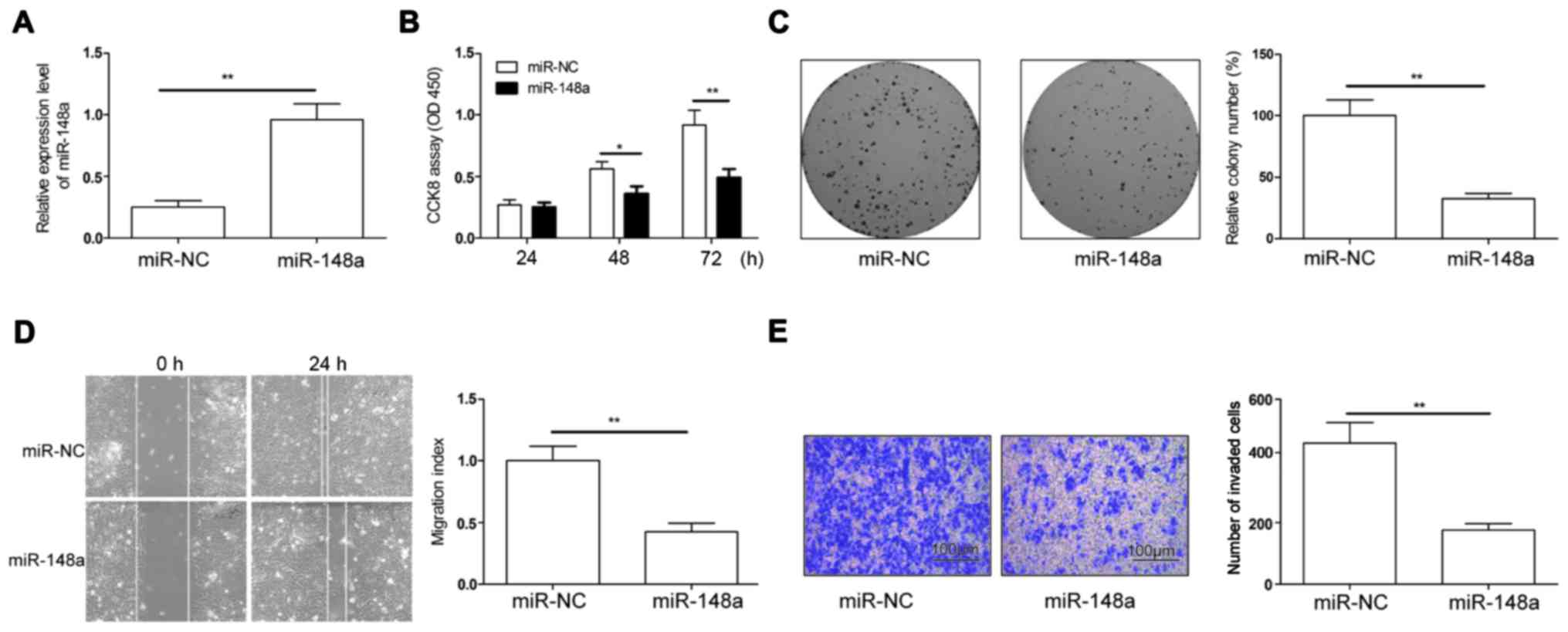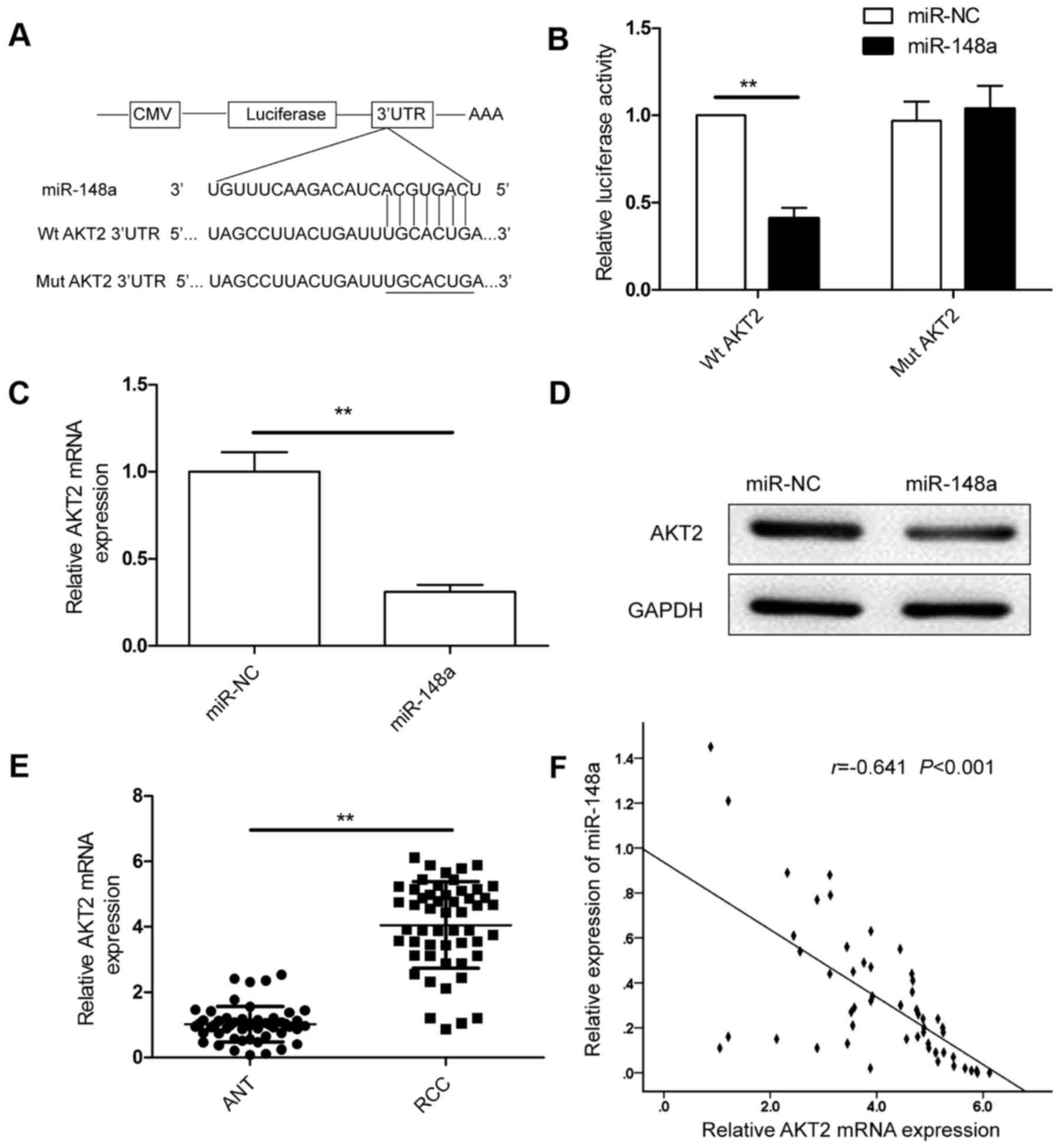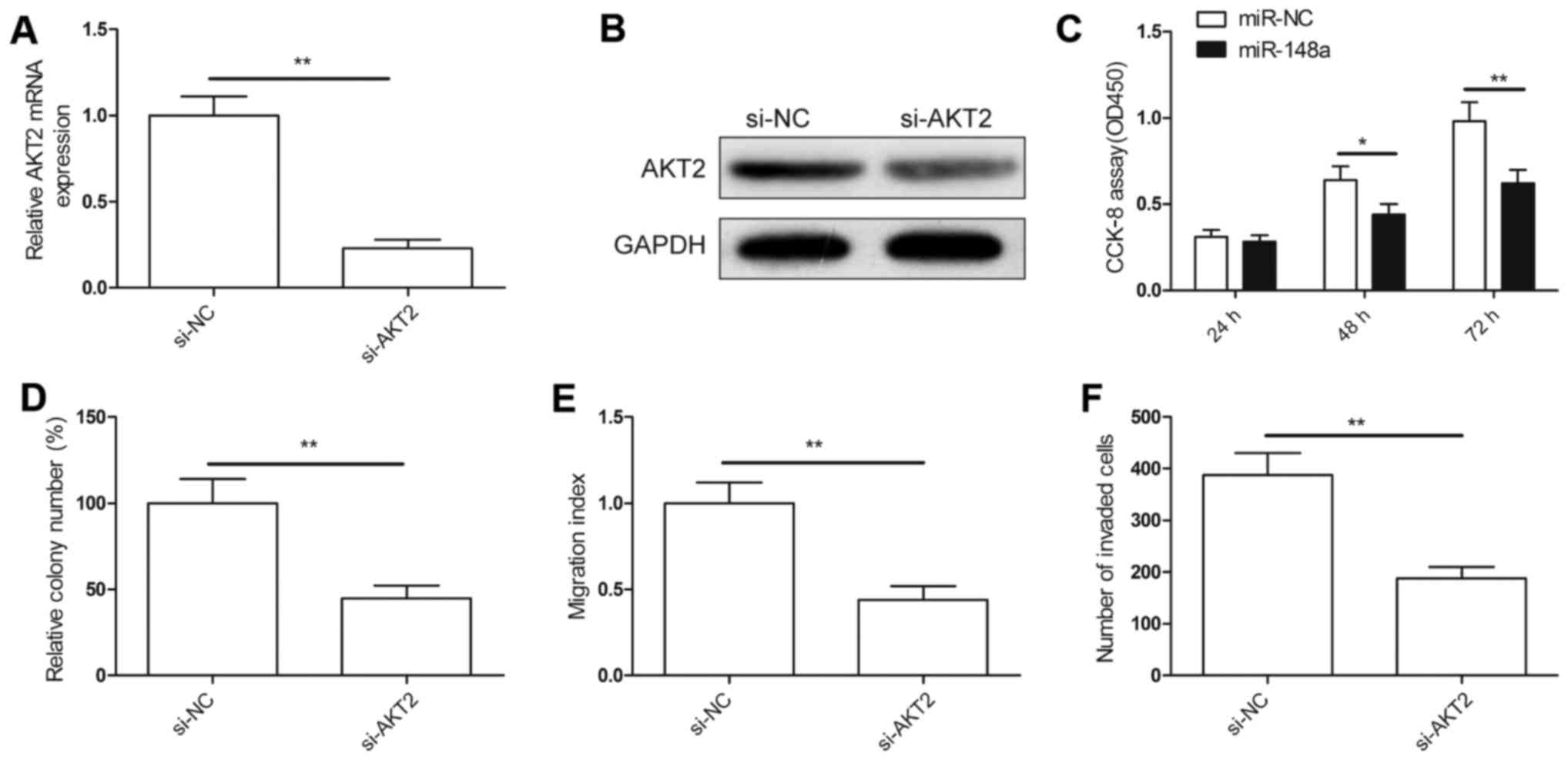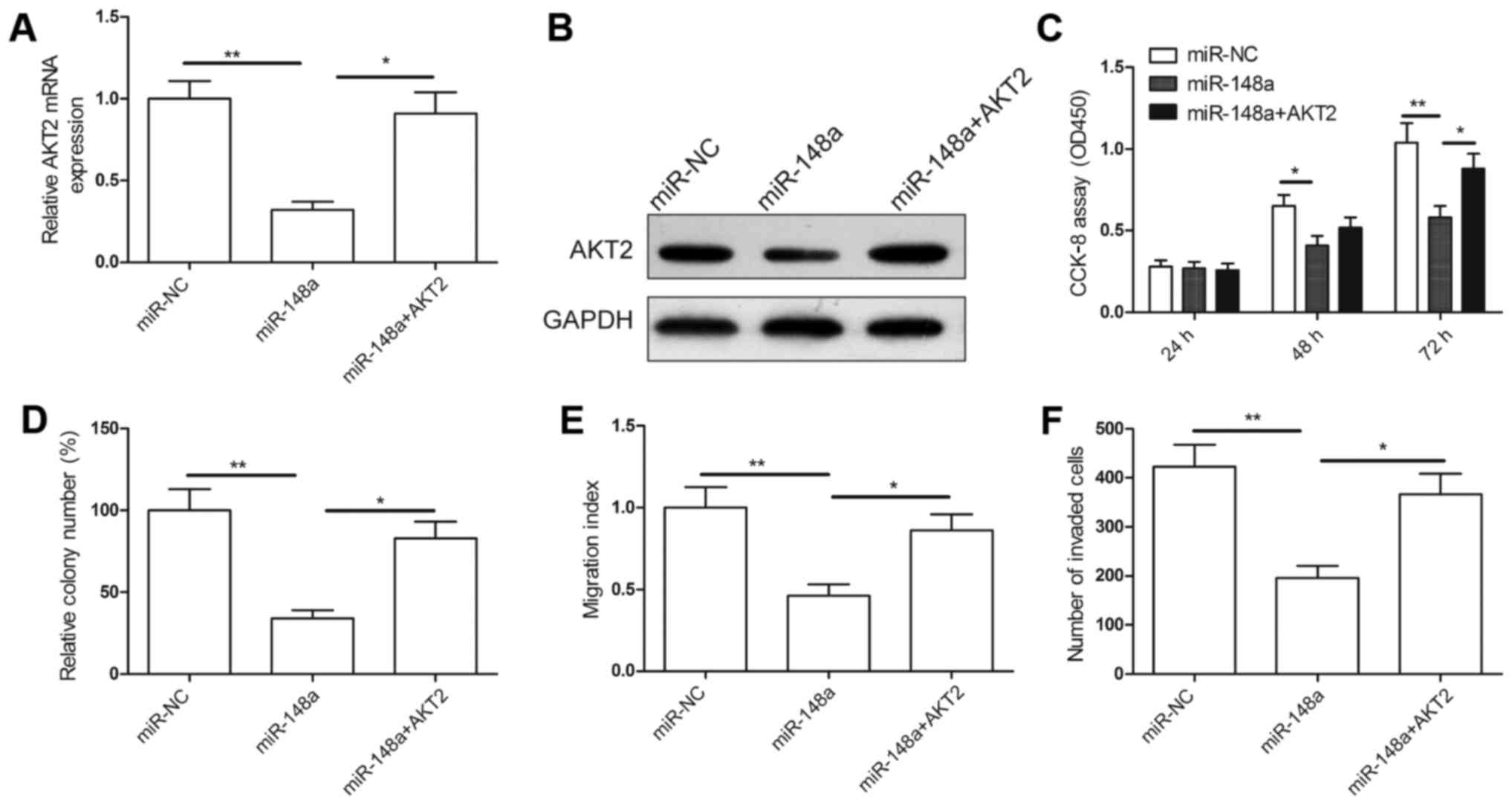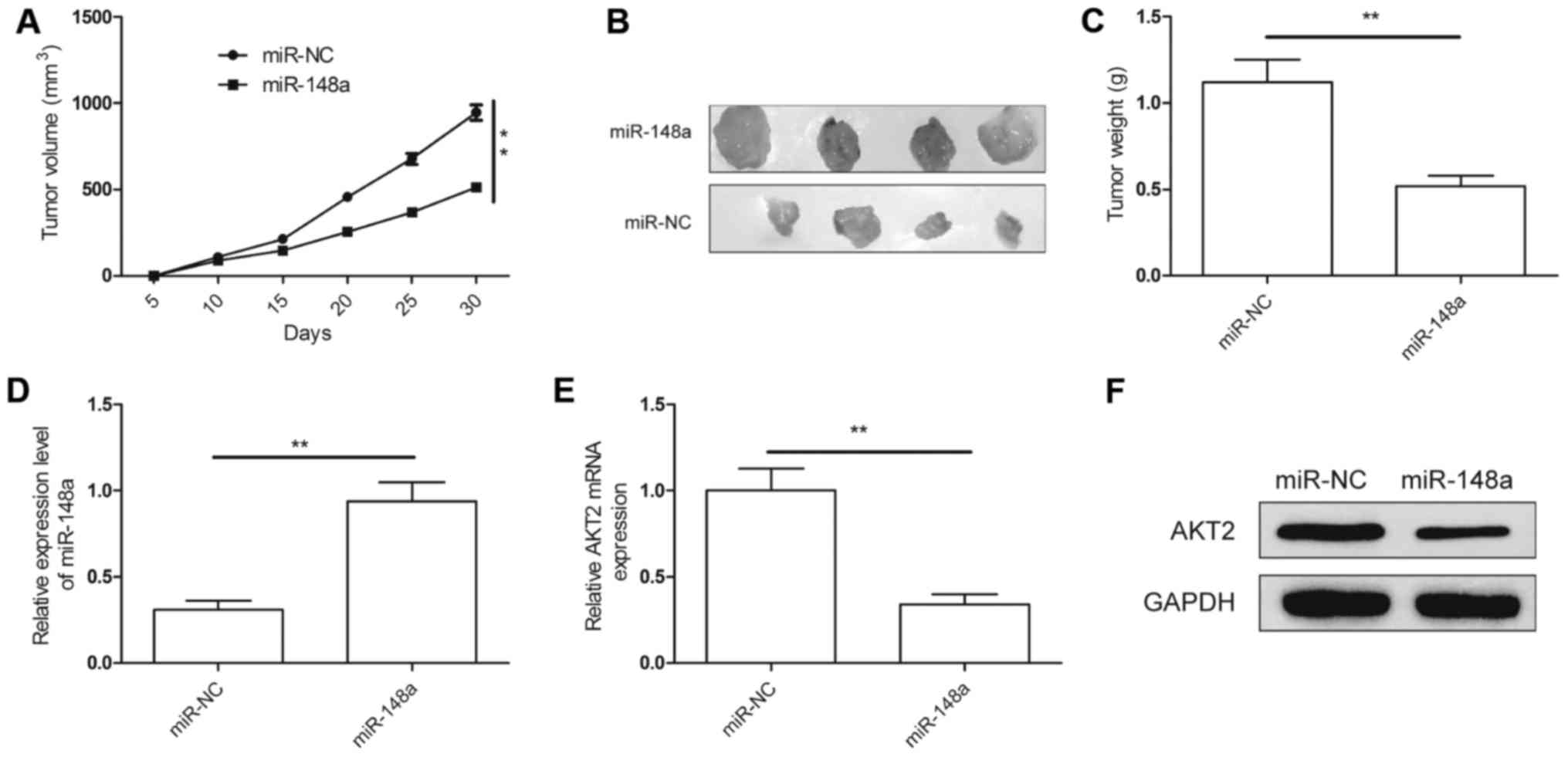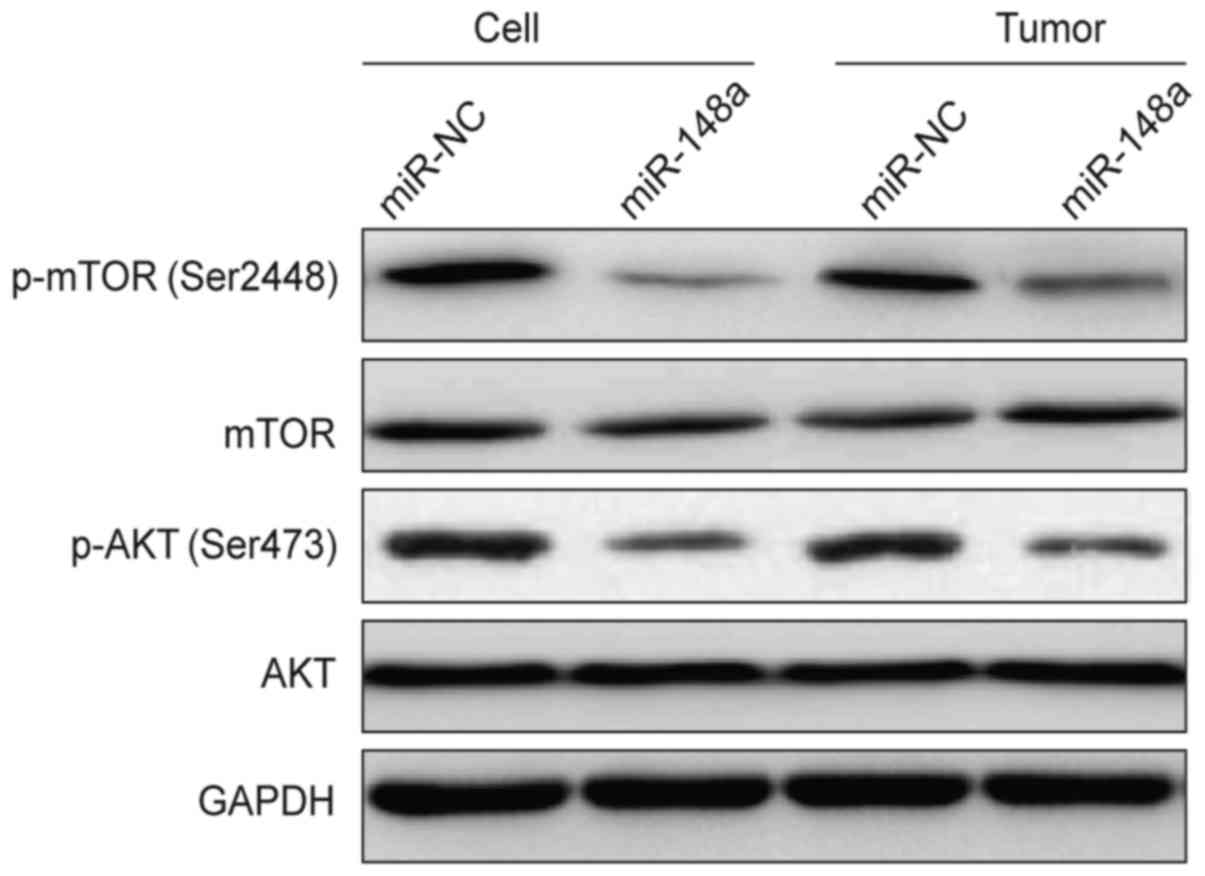miR-148a suppresses human renal cell carcinoma malignancy by targeting AKT2
Retraction in: /10.3892/or.2022.8454
- Authors:
- Published online on: November 18, 2016 https://doi.org/10.3892/or.2016.5257
- Pages: 147-154
Abstract
Introduction
Renal cell carcinoma (RCC) is the most common malignant cancer in the adult kidney, and accounts for approximately 85% of all primary malignant kidney tumors and 3% of all cancers in adults (1,2). Despite increased early detection of RCC and more frequent surgery, 30% of RCC patients develop metastases after surgery, which are associated with poor prognosis (3–5). Therefore, there is an urgent need to elucidate the mechanisms of RCC which regulate the initiation and progression of RCC to provide useful information for the clinical management of RCC.
MicroRNAs (miRNAs) are small endogenous non-coding RNAs composed of ~19–25 nucleotides that negatively regulate gene expression by degrading target mRNAs or repressing protein translation by binding to the 3′ untranslated region (3′UTR) of their target mRNAs (6). Accumulating studies suggest that deregulation of miRNAs is associated with carcinogenesis (7). miRNAs have been shown to function as either oncogenes or tumor suppressors in different types of cancer, which manifest as the regulation of cellular proliferation, cell death and angiogenesis in tumor progression (8,9). Numerous related studies have been carried out in RCC and have shown that dysregulation in miRNAs are involved in the occurrence and progression of RCC by regulating the expression of their target oncogenes and tumor suppressors (10,11), suggesting that miRNAs could serve as diagnostic markers or therapeutic agents for RCC.
Deregulation of miR-148a has been reported in several types of cancer, including breast cancer (12), hepatocellular carcinoma (13), osteosarcoma (14), gastric cancer (15), colorectal cancer (16), medulloblastoma (17), bladder cancer (18) and non-small cell lung cancer (19). miR-148a has been previously characterized as a tumor suppressor or oncogene with functions in regulating cell proliferation, apoptosis, and migration and invasion in several types of cancer (12–20). However, the detailed biological function and underlying molecular mechanisms of miR-148a in human RCC remain unclear. Therefore, the aims of this study were to investigate the clinical significance, biological function and underlying molecular mechanisms of miR-148a in RCC.
Materials and methods
Human RCC clinical specimens
A total of 52 paired clear cell RCC and corresponding adjacent noncancerous tissues (ANT) were obtained sequentially from patients who underwent radical nephrectomy in the People's Hospital of Qinghai (Xining, China) between July 2013 and July 2015. Noncancerous renal tissues were obtained at least 5 cm away from the tumor site. All tissue specimens were snap-frozen in liquid nitrogen until use. The basic clinical characteristics of these patients were collected, and are listed in Table I. The study protocol was approved by the Ethics Committee of the People's Hospital of Qinghai and a written informed consent was obtained from all patients involved in this study.
Table I.Correlation between clinicopathological features and miR-148a expression in tissues of the RCC cases. |
Cell culture
Four human RCC cell lines (786-O, ACHN, Caki-1, and Caki-2) and human renal proximal tubule epithelial cell line (HK-2) were all obtained from American Type Culture Collection (ATCC; Rockville, MD, USA). The cells were cultured in RPMI-1640 medium supplemented with 10% fetal bovine serum (FBS) (both from Gibco, Grand Island, NY, USA), 50 U/ml penicillin or 50 µg/ml streptomycin at 37°C in a 5% CO2 humidified incubator.
RNA extraction and real-time PCR assays for miR-148a and AKT2 detection
Total RNA was extracted from the cultured cell and tissues using TRIzol reagent (Invitrogen, Carlsbad, CA, USA) according to the manufacturer's instructions. The RNA was quantified using NanoDrop ND-100 spectrophotometer (NanoDrop Technologies, Wilmington, DE, USA) at 260 nm. For detection of the miR-148a expression level, quantitative PCR was performed using TaqMan miRNA assays with specific primers for miR-148a according to the protocol with endogenous U6 snRNA as the control under an ABI PRISM 7900 sequence detection system (both from Applied Biosystems Life Technologies, Foster City, CA, USA). For detection of AKT2 mRNA expression, cDNA was synthesized from 500 ng total RNA using the Primer Script RT reagent kit (Takara Bio, Inc., Otsu, Japan). Quantitative PCR analysis of the AKT2 expression at the mRNA level was performed using Fast SYBR-Green Master Mix (Applied Biosystems Life Technologies) under ABI PRISM 7900 sequence detection system, with GAPDH used as an internal control. The primers of AKT2 and GAPDH used in this study were previously described (21). The relative miRNA or mRNA expression was quantified by measuring cycle threshold (Ct) values and normalized using the 2−∆∆Ct method.
Cell transfection
The miR-148a mimic (miR-148a) and corresponding negative control (miR-NC) were designed and purchased from RiboBio (Guangzhou, China). siRNAs against AKT2 (si-AKT2) and the corresponding scramble control (si-NC) were purchased from GenePharma (Shanghai, China). The AKT2 expression vector (pcDNA 3.0 containing AKT2 coding region) was obtained from Dr Ju Peng (Jilin University, Changchun, China), which was used for the ‘rescue’ experiments. Transfection was performed using Lipofectamine 2000 (Invitrogen) according to the manufacturer's instructions.
Cell proliferation and colony formation assays
Cell proliferation was assessed using a tetrazolium salt (WST-8)-based colormetric assay provided by the Cell Counting Kit-8 (CCK-8; Dojindo Laboratories, Kumamoto, Japan). Briefly, transfected cells were seeded into 96-well plates (5×103 cells/well) with 100 µl culture medium. At the indicated time-points (24, 48 and 72 h), 10 µl of CCK-8 solution was added to the wells and cultured additionally for 4 h at 37°C. Cell viability was determined from absorbance readings at 450 nm using a microplate reader (Bio-Rad Laboratories, Gaithersburg, MD, USA).
For the colony formation assay, 1×103 transfected cells were plated on 6-well plates and incubated for 10 days. Then, the cells were rinsed with PBS and fixed with 1% formaldehyde for 30 min and stained with 1% crystal violet for 10 min. Finally images were captured of the colonies and the number of colonies was counted under a light microscope (Olympus, Tokyo, Japan).
Wound healing assays
For the wound healing assay, transfected cells were seeded on 6-well plates with fresh medium containing 10% FBS at a density of 2×105 cells/well. After formation of a confluent monolayer of cells, the membrane was scratched using a sterile 100-µl pipette. The cell culture medium was replaced and images of the wound were taken at different time-points (0 and 24 h after scratching) under a light microscope (Olympus). To assess the migration rate, we measured the fraction of cell coverage across the line.
Invasion assays
A 24-well Transwell plate with 8-µm pore polycarbonate membrane inserts (Corning Costar Corp., Cambridge, MA, USA) was employed to assess invasive capacity of the cells according to the manufacturer's instructions. Briefly, 3×104 transfected cells suspended in serum-free medium were added to the upper chamber pre-coated with Matrigel (BD Biosciences, Bedford, MA, USA). Medium containing 10% FBS was added to the bottom chamber as a chemoattractant. After 48 h of incubation, the cells invading into the lower surface of the membrane were fixed and stained with methanol mixed with crystal violet and then counted under a light microscope (Olympus).
Vector construction and luciferase reporter assay
A luciferase reporter assay was performed using the firefly luciferase-expressing vector psiCHECK2 (Promega Corp., Madison, WI, USA). A wild-type 3′UTR segment of AKT2 mRNA containing the putative miR-148a binding sites was amplified and cloned into the XhoI and NotI sites downstream of the luciferase reporter gene in psiCHECK-2, named as Wt-AKT2-3′UTR. Mutations of their 3′UTR sequence were created using QuickChange Site-Directed Mutagenesis kit (Agilent Technologies, Inc., Palo Alto, CA, USA) following the manufacturer's instructions, referred to Mut-AKT2-3′UTR. For the luciferase activity assay, cells were seeded into 12-well plates overnight before transfection, and then co-transfected with 100 ng of psiCHECK-2 vectors, which harbored the AKT2 3′UTR wild-type or mutant constructs, 100 ng pRL-TK Renilla luciferase report vector as the internal control, 100 nM of miR-148a or miR-NC. After 48 h, the luciferase activity was measured with a dual-luciferase assay kit (Promega Corp.) according to the manufacturer's instructions. Renilla luciferase activity was normalized to firefly luciferase activity.
Western blot analysis
The cells or tissues were harvested and incubated on ice with lysis buffer (Boster Inc., Shanghai, China). Total protein concentration was detected using a bicinchoninic acid (BCA) protein assay kit (Boster Inc.); 50 µg of protein was electrophoresed through 10% SDS polyacrylamide gels and were then transferred to a PVDF membrane (Millipore Corp., Billerica, MA, USA). Membranes were blocked using 5% non-fat milk for 1 h and blotted in antibodies against glyceraldehyde 3-phosphate dehydrogenase (GAPDH), AKT2, AKT, p-Akt (Ser473), mTOR and p-mTOR (Ser2448) at 4°C overnight. All antibody were purchased from Santa Cruz Biotechnology, Inc. (Santa Cruz, CA, USA). After washing with TBST, the membranes were incubated in HRP-conjugated goat anti-mouse or anti-rabbit secondary antibodies (Santa Cruz Biotechnology, Inc.) for 2 h at room temperature. Proteins band were visualized with an ECL chemiluminescent kit (ECL-Plus; Thermo Fisher Scientific, Waltham, MA, USA) and exposure to chemiluminescent film.
In vivo tumor growth assay
All experimental procedures involving animals were performed in accordance with the Guidelines for the Care and Use of Laboratory Animals and Institutional Ethical Guidelines of People's Hospital of Qinghai. The animal studies and experimental protocol were approved by the Institutional Animal Care and Use Committee of the People's Hospital of Qinghai. To establish RCC xenografts, 2×106 786-O cells stably expressing miR-148a or miR-NC were subcutaneously implanted into the flanks of male BALB/c-nude mice (n=10 per group, 3–4 weeks of age). Tumor sizes were measured with callipers to estimate the volume (V) from day 5 to day 30 after injection using the formula: V (mm3) = [width2 (mm2) × length (mm)]/2. Thirty days after implantation, the animals were sacrificed, and tumors were dissected and weighed. A part of the tumor tissues was frozen in liquid nitrogen and stored at −80°C for qRT-PCR and western blot analysis.
Statistical analysis
All data are expressed as mean ± SD (standard deviation) from at least three independent experiments. Differences were determined by two-tailed Student's t-test by one-way ANOVA. Associations of miR-148a expression and AKT2 expression were estimated using Spearman's correlation analysis. Statistical analysis was performed using the SPSS® Statistical Package, version 19.0 (SPSS Inc., Chicago, IL, USA) for Windows®. In all cases, P<0.05 was considered statistically significant.
Results
miR-148a is downregulated in RCC cell lines and tissues
To investigate the role of miR-148a in RCC development and progression, the expression of miR-148a was examined in four human RCC cell lines (786-O, ACHN, Caki-1, and Caki-2) and a human renal proximal tubule epithelial cell line (HK-2). Results of qRT-PCR showed that expression of miR-148a was decreased in all of the RCC cell lines compared with the HK-2 cells (Fig. 1A). In addition, the levels of miR-148a in 52 RCC tissues and ANT were detected by qRT-PCR. Compared with the noncancerous tissues, the miR-148a expression level was downregulated (P<0.001; Fig. 1B). Clinical patients were divided into two groups according to the median of miR-148a expression in the RCC samples. The downregulation of miR-148a was significantly associated with large tumor size, advanced TNM stage, and lymph node metastasis (Table I). Taken together, these results suggest miR-148a as a potential biomarker for prediction of prognosis in RCC.
miR-148a inhibits proliferation, migration and invasion of RCC cells in vitro
To determine the biological function of miR-148a in RCC progression, we re-introduced miR-148a into 786-O cells, which exploited the lowest expression among the four RCC cell lines (Fig. 1A). miR-148a expression was significantly increased in the 786-O cells transfected with miR-148a mimics compared to those transfected with negative control mimic (miR-NC), as shown by qRT-PCR (Fig. 2A). CCK-8 assay showed that miR-148a overexpression significantly inhibited cell proliferation (Fig. 2B). Consistently, ectopic miR-148a expression dramatically suppressed colony formation (Fig. 2C). Given that miR-148a expression was associated with lymph node metastasis in RCC patients, we next examined whether miR-148a could affect RCC cell migration and invasion. Results showed that miR-148a overexpression distinctly abrogated the migration and invasion of 786-O cells (Fig. 2D and E). Our results suggest that miR-148a suppresses proliferation, migration and invasion of RCC cells.
AKT2 is the direct target of miR-148a in RCC cells
According to the bioinformatic analysis, the 3′UTR of AKT2 was complementarily matched to the miR-148a sequence (Fig. 3A). To test whether miR-148a was able to regulate AKT2 directly, we performed dual luciferase reporter experiments, and found that miR-148a significantly reduced luciferase activity of wild-type AKT2 3′UTR, whereas the luciferase activity of mutant AKT2 3′UTR remained unchanged (Fig. 3B). Furthermore, miR-148a overexpression blocked AKT2 expression at both the mRNA and protein levels in the RCC cells (Fig. 3C and D). The expression of AKT2 was increased in the RCC clinical samples (Fig. 3E), and was inversely correlated with miR-148a in the RCC tissues (r=−0.641, P<0.001; Fig. 3F). These data supported our hypothesis that miR-148a directly targets the AKT2 gene in RCC.
miR-148a suppresses cell proliferation and migration via the suppression of AKT2
We assessed whether targeting of AKT2 would mimic miR-148a-induced phenotypes on cell proliferation migration, and invasion. Firstly, we knocked down AKT2 in the 786-O cells by si-AKT2, and found that AKT2 expression was inhibited both at the mRNA and protein levels (Fig. 4A and B). In addition, we demonstrated that downregulation of AKT2 efficiently inhibited cell proliferation (Fig. 4C), decreased colony formation ability (Fig. 4D), and suppressed migration (Fig. 4E) and invasion (Fig. 4F) in the 786-O cells, and had effects similar to those of the overexpression of miR-148a.
Next, we examined whether AKT2 overexpression could rescue the inhibitory effects of miR-148a on RCC cell proliferation, migration and invasion. The overexpressing AKT2 plasmid was introduced in the 786-O cells that had been transfected with the miR-148a mimic and mimic NC. RT-PCR and western blot analysis confirmed that the miR-338-3p mimics markedly and specifically decreased AKT2 expression, whereas transfection of the overexpressing AKT2 plasmid restored AKT2 expression in the 786-O cells (Fig. 5A and B). Our results also demonstrated that reintroduction of AKT2 significantly abrogated the suppression of cell proliferation, colony formation, migration and invasion in the 786-O cells induced by miR-148a (Fig. 5C-F). Collectively, these results suggest that miR-148a suppresses cell proliferation and migration in RCC cells via the suppression of AKT2.
miR-148a inhibits tumor growth in vivo
An animal experiment was employed to verify the function of miR-148a in RCC growth. 786-O/miR-148a and 786-O/miR-NC cells were subcutaneously injected into nude mice. Tumor sizes were measured every 5 days until the mice were sacrificed at 30 days post-implantation. The results demonstrated that tumor growth was slower in the 786-O/miR-148 group compared with that in the miR-NC group (Fig. 6A). Thirty days after injection, the nude mice were sacrificed, and the tumor tissues were stripped and weighed. The tumor size (Fig. 6B) and weight (Fig. 6C) were significantly decreased in the 786-O/miR-148a group compared with the size and weight in the 786-O/miR-NC group. In addition, we also found that the miR-148a expression level was upregulated (Fig. 6D), while the AKT2 expression at the mRNA level (Fig. 6E) and protein level (Fig. 6F) was downregulated in the 786-O/miR-148a group. These results suggest that miR-148a suppresses RCC tumorigenicity in vivo by repressing AKT2 expression.
miR-148a inhibits the Akt pathway in vitro and in vivo
AKT2 belongs to the Akt family that functions as the hub in the PI3K/Akt signaling pathway. We therefore assessed the levels of AKT2 downstream proteins including p-Akt (Ser473) and p-mTOR (Ser2448) in the 786-O cells 48 h after transfection with miR-148a or miR-NC, and found that overexpression of miR-148a decreased the phosphorylation levels of Akt and mTOR, whereas the total AKT and mTOR level were not changed (Fig. 7). Moreover, we also determined expression of these proteins in tumor tissues from the RCC xenograft mice. Our results further showed that p-Akt and p-mTOR expression was decreased in the 786-O/miR-148a group compared to that in the 786-O/miR-NC group (Fig. 7). These results suggest that miR-148a overexpression inhibits the AKT signaling pathway in vitro and in vivo.
Discussion
Recent advances have revealed that dysregulation of miRNAs is involved in the progression and development of cancer (8,9). Modulation of miRNA expression has been proposed to be a feature of various types of cancer, including RCC, which may benefit the development of diagnostic markers and therapeutic agents for RCC (10,11). Here, we found that miR-148a was significantly downregulated in RCC cell lines and tissue specimens relative to normal renal cells and adjacent noncancerous tissues. Meanwhile, we also discovered that miR-148a inhibited RCC growth and metastasis by regulating AKT2 expression. These findings provided a mechanism by which miR-148a suppresses tumorigenesis in RCC.
miR-148a, a member of the miR-148 family, has been reported to correlate with diverse biological functions, including proliferation, migration, invasion, and cell cycle progression (12–19). In multiple types of tumors, miR-148a functions as a tumor suppressor to block the growth and metastasis of cancer cells (12–14,16–20). On the contrary, in glioblastoma and gastric cancer, miR-148a acts as an oncomiR to promote cancer cell proliferation and survival (15,22). These studies indicated that miR-148a can acts as an oncomiR or tumor suppressor, depending on tumor type. In the present study, we provide the first demonstration that miR-148a expression was downregulated in human RCC tissues and cell lines. We also found that restoration of miR-148a inhibited RCC cell proliferation, colony formation, migration and invasion in vitro, as well as suppressed RCC tumor growth in vivo. Thus, our in vitro and in vivo findings together suggest that miR-148a functions as a tumor suppressor in RCC.
It is well known that miRNAs exert their roles in tumor proliferation, apoptosis, migration, invasion and metastasis through regulation of target gene expression (7). Thus, to explore the mechanism underlying the function of miR-148a in RCC, the miR-148a target was predicted using biological software. We identified AKT2 as a potential candidate. AKT2, an isoform of the AKT family, has been reported to function as an oncogene by primarily enhancing the survival, migration and invasion of cancer cells (23–25). Recently studies have shown that AKT2 expression was elevated in RCC tissues, and it has an important role in the pathogenesis and progression of RCC (26). In addition, AKT2 has been shown to be regulated by multiple miRNAs, such as miR-29b (21), miR-124 (27), miR-612 (28), miR-137 (29) and miR-615 (30). In this study, we indentified AKT2 as a target of miR-148a in RCC. We also found that downregulation of AKT2 phenotypically copied miR-148a-induced phenotypes, whereas re-expression of AKT2 reversed the suppressive effects of miR-148a in RCC cells. These results suggest that miR-148a exerts tumor suppressor roles in RCC by repressing AKT2.
AKT2 is a significant member of the PI3K/AKT pathway, which is recognized as one of the most frequently activated signaling pathways in human cancers (31,32). This pathway is involved in regulating various cancer processes, such as cell proliferation, apoptosis, migration, and metastasis (33,34). It has been reported that AKT exerts its biological function by phosphorylating its downstream substrates including mTOR (35,36). Therefore, we investigated whether miR-148a affects the AKT pathway and its downstream protein. We found that overexpression of miR-148a significantly suppressed the phosphorylation of AKT, as well as inhibited its downstream effectors, p-mTOR expression, but not total AKT and mTOR in vitro and in vivo. These findings suggest that miR-148 inhibits RCC growth via regulating the AKT signaling pathway.
In conclusion, the results presented here demonstrated that the miR-148a expression level was downregulated in RCC cell lines and tissues, and its expression level was significantly associated with large tumor size, advanced TNM stage and lymph node metastasis, and that miR-148a acts as a tumor suppressor inhibiting the proliferation, migration and invasion of RCC cells, as well as suppressing tumor growth in vivo by negative regulation of its target AKT2 and regulation of the AKT signaling pathway. Thus, miR-1 may be a potential therapeutic target for RCC treatment.
References
|
Siegel R, Ma J, Zou Z and Jemal A: Cancer statistics, 2014. CA Cancer J Clin. 64:9–29. 2014. View Article : Google Scholar : PubMed/NCBI | |
|
DeSantis CE, Lin CC, Mariotto AB, Siegel RL, Stein KD, Kramer JL, Alteri R, Robbins AS and Jemal A: Cancer treatment and survivorship statistics, 2014. CA Cancer J Clin. 64:252–271. 2014. View Article : Google Scholar : PubMed/NCBI | |
|
Capitanio U and Montorsi F: Renal cancer. Lancet. 387:894–906. 2016. View Article : Google Scholar : PubMed/NCBI | |
|
Chow WH, Dong LM and Devesa SS: Epidemiology and risk factors for kidney cancer. Nat Rev Urol. 7:245–257. 2010. View Article : Google Scholar : PubMed/NCBI | |
|
Pantuck AJ, Zisman A and Belldegrun AS: The changing natural history of renal cell carcinoma. J Urol. 166:1611–1623. 2001. View Article : Google Scholar : PubMed/NCBI | |
|
Ying SY, Chang DC, Miller JD and Lin SL: The microRNA: Overview of the RNA gene that modulates gene functions. Methods Mol Biol. 342:1–18. 2006.PubMed/NCBI | |
|
Lu J, Getz G, Miska EA, Alvarez-Saavedra E, Lamb J, Peck D, Sweet-Cordero A, Ebert BL, Mak RH, Ferrando AA, et al: MicroRNA expression profiles classify human cancers. Nature. 435:834–838. 2005. View Article : Google Scholar : PubMed/NCBI | |
|
McManus MT: MicroRNAs and cancer. Semin Cancer Biol. 13:253–258. 2003. View Article : Google Scholar : PubMed/NCBI | |
|
Calin GA and Croce CM: MicroRNA-cancer connection: The beginning of a new tale. Cancer Res. 66:7390–7394. 2006. View Article : Google Scholar : PubMed/NCBI | |
|
Gu L, Li H, Chen L, Ma X, Gao Y, Li X, Zhang Y, Fan Y and Zhang X: MicroRNAs as prognostic molecular signatures in renal cell carcinoma: A systematic review and meta-analysis. Oncotarget. 6:32545–32560. 2015.PubMed/NCBI | |
|
Li JY, Yong TY, Michael MZ and Gleadle JM: Review: The role of microRNAs in kidney disease. Nephrology (Carlton). 15:599–608. 2010. View Article : Google Scholar : PubMed/NCBI | |
|
Xu X, Zhang Y, Jasper J, Lykken E, Alexander PB, Markowitz GJ, McDonnell DP, Li QJ and Wang XF: MiR-148a functions to suppress metastasis and serves as a prognostic indicator in triple-negative breast cancer. Oncotarget. 7:20381–20394. 2016.PubMed/NCBI | |
|
Pan L, Huang S, He R, Rong M, Dang Y and Chen G: Decreased expression and clinical significance of miR-148a in hepatocellular carcinoma tissues. Eur J Med Res. 19:682014. View Article : Google Scholar : PubMed/NCBI | |
|
Ma W, Zhang X, Chai J, Chen P, Ren P and Gong M: Circulating miR-148a is a significant diagnostic and prognostic biomarker for patients with osteosarcoma. Tumour Biol. 35:12467–12472. 2014. View Article : Google Scholar : PubMed/NCBI | |
|
Xia J, Guo X, Yan J and Deng K: The role of miR-148a in gastric cancer. J Cancer Res Clin Oncol. 140:1451–1456. 2014. View Article : Google Scholar : PubMed/NCBI | |
|
Hibino Y, Sakamoto N, Naito Y, Goto K, Oo HZ, Sentani K, Hinoi T, Ohdan H, Oue N and Yasui W: Significance of miR-148a in colorectal neoplasia: Downregulation of miR-148a contributes to the carcinogenesis and cell invasion of colorectal cancer. Pathobiology. 82:233–241. 2015. View Article : Google Scholar : PubMed/NCBI | |
|
Yogi K, Sridhar E, Goel N, Jalali R, Goel A, Moiyadi A, Thorat R, Panwalkar P, Khire A, Dasgupta A, et al: MiR-148a, a microRNA upregulated in the WNT subgroup tumors, inhibits invasion and tumorigenic potential of medulloblastoma cells by targeting neuropilin 1. Oncoscience. 2:334–348. 2015. View Article : Google Scholar : PubMed/NCBI | |
|
Lombard AP, Mooso BA, Libertini SJ, Lim RM, Nakagawa RM, Vidallo KD, Costanzo NC, Ghosh PM and Mudryj M: miR-148a dependent apoptosis of bladder cancer cells is mediated in part by the epigenetic modifier DNMT1. Mol Carcinog. 55:757–767. 2016. View Article : Google Scholar : PubMed/NCBI | |
|
Joshi P, Jeon YJ, Laganà A, Middleton J, Secchiero P, Garofalo M and Croce CM: MicroRNA-148a reduces tumorigenesis and increases TRAIL-induced apoptosis in NSCLC. Proc Natl Acad Sci USA. 112:8650–8655. 2015. View Article : Google Scholar : PubMed/NCBI | |
|
Xu Q, Jiang Y, Yin Y, Li Q, He J, Jing Y, Qi YT, Xu Q, Li W, Lu B, et al: A regulatory circuit of miR-148a/152 and DNMT1 in modulating cell transformation and tumor angiogenesis through IGF-IR and IRS1. J Mol Cell Biol. 5:3–13. 2013. View Article : Google Scholar : PubMed/NCBI | |
|
Li M, Li H, Liu X, Xu D and Wang F: MicroRNA-29b regulates TGF-β1-mediated epithelial-mesenchymal transition of retinal pigment epithelial cells by targeting AKT2. Exp Cell Res. 345:115–124. 2014. View Article : Google Scholar : PubMed/NCBI | |
|
Kim J, Zhang Y, Skalski M, Hayes J, Kefas B, Schiff D, Purow B, Parsons S, Lawler S and Abounader R: microRNA-148a is a prognostic oncomiR that targets MIG6 and BIM to regulate EGFR and apoptosis in glioblastoma. Cancer Res. 74:1541–1553. 2014. View Article : Google Scholar : PubMed/NCBI | |
|
Pereira L, Horta S, Mateus R and Videira MA: Implications of Akt2/Twist crosstalk on breast cancer metastatic outcome. Drug Discov Today. 20:1152–1158. 2015. View Article : Google Scholar : PubMed/NCBI | |
|
Agarwal E, Brattain MG and Chowdhury S: Cell survival and metastasis regulation by Akt signaling in colorectal cancer. Cell Signal. 25:1711–1719. 2013. View Article : Google Scholar : PubMed/NCBI | |
|
Cheng GZ, Zhang W and Wang LH: Regulation of cancer cell survival, migration, and invasion by Twist: AKT2 comes to interplay. Cancer Res. 68:957–960. 2008. View Article : Google Scholar : PubMed/NCBI | |
|
Toschi A, Lee E, Gadir N, Ohh M and Foster DA: Differential dependence of hypoxia-inducible factors 1 alpha and 2 alpha on mTORC1 and mTORC2. J Biol Chem. 283:34495–34499. 2008. View Article : Google Scholar : PubMed/NCBI | |
|
Jiang CF, Li DM, Shi ZM, Wang L, Liu MM, Ge X, Liu X, Qian YC, Wen YY, Zhen LL, et al: Estrogen regulates miRNA expression: Implication of estrogen receptor and miR-124/AKT2 in tumor growth and angiogenesis. Oncotarget. 7:36940–36955. 2016.PubMed/NCBI | |
|
Sheng L, He P, Yang X, Zhou M and Feng Q: miR-612 negatively regulates colorectal cancer growth and metastasis by targeting AKT2. Cell Death Dis. 6:e18082015. View Article : Google Scholar : PubMed/NCBI | |
|
Wu L, Chen J, Ding C, Wei S, Zhu Y, Yang W, Zhang X, Wei X and Han D: MicroRNA-137 contributes to dampened tumorigenesis in human gastric cancer by targeting AKT2. PLoS One. 10:e01301242015. View Article : Google Scholar : PubMed/NCBI | |
|
Bai Y, Li J, Li J, Liu Y and Zhang B: MiR-615 inhibited cell proliferation and cell cycle of human breast cancer cells by suppressing of AKT2 expression. Int J Clin Exp Med. 8:3801–3808. 2015.PubMed/NCBI | |
|
Chen H, Zhou L, Wu X, Li R, Wen J, Sha J and Wen X: The PI3K/AKT pathway in the pathogenesis of prostate cancer. Front Biosci (Landmark Ed). 21:1084–1091. 2016. View Article : Google Scholar : PubMed/NCBI | |
|
Yang SX, Polley E and Lipkowitz S: New insights on PI3K/AKT pathway alterations and clinical outcomes in breast cancer. Cancer Treat Rev. 45:87–96. 2016. View Article : Google Scholar : PubMed/NCBI | |
|
Robbins HL and Hague A: The PI3K/Akt pathway in tumors of endocrine tissues. Front Endocrinol (Lausanne). 6:1882016.PubMed/NCBI | |
|
Guo H, German P, Bai S, Barnes S, Guo W, Qi X, Lou H, Liang J, Jonasch E, Mills GB, et al: The PI3K/AKT pathway and renal cell carcinoma. J Genet Genomics. 42:343–353. 2015. View Article : Google Scholar : PubMed/NCBI | |
|
Lee JJ, Loh K and Yap YS: PI3K/Akt/mTOR inhibitors in breast cancer. Cancer Biol Med. 12:342–354. 2015.PubMed/NCBI | |
|
Hudes GR: Targeting mTOR in renal cell carcinoma. Cancer 115 (Suppl 10). 2313–2320. 2009. View Article : Google Scholar |



